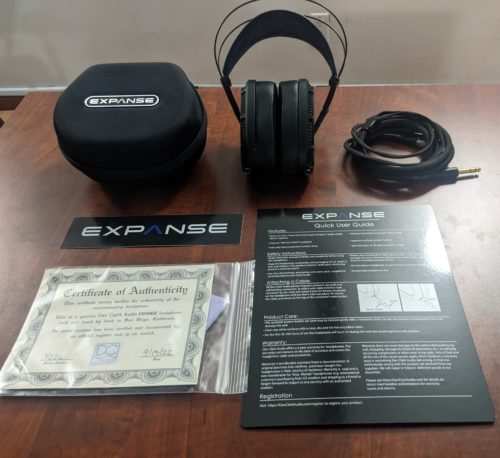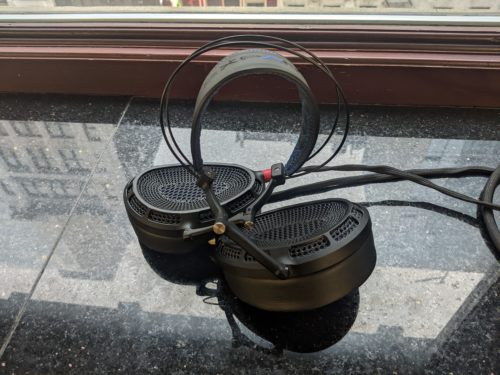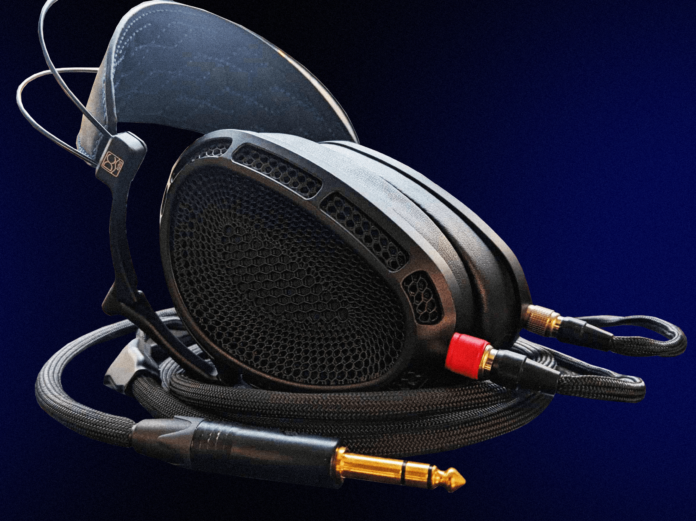Dan Clark Audio The Expanse Review
A well-recognized name among audiophiles, Dan Clark Audio released a premium closed-back, over-ear headphone called Stealth to much critical and consumer acclaim. About a year later, Dan Clark Audio has recently released its open-back alternative to Stealth: the Expanse. Packing in quite a visual presence with ergonomic design, enormous planar drivers, and the inclusion of Acoustic Metamaterial Tuning System proprietary technology, is the expanse really – I mean, really – worth its $3,999 price tag? I’ve sharpened my most critical of ears for a headphone at this price point, let’s take a look at the impressive tech packed into the Expanse before we get into just what it sounds like.

What’s In The Box?
-The Expanse open-back headphones
-Firm Carrying Case
-VIVO headphone cable
-Certificate of Authenticity
Look and Feel
The Expanse’s look is based on the style of Dan Clark Audio’s Stealth headphone, but with an added geometric, hexagonal patterned grill on the back of the cans that emphasizes its open-back design.
I’m genuinely impressed with the flexibility and ergonomics present through out the entirety of the Expanse’s structure: the cans fold in on themselves deep into the headband, enabled by hinged, folding gambles made of carbon fiber that provide lightweight durability. Once folded, they fit extra snugly into the included firm carrying case. The aluminum-nickel band keeping the headphones together is unusually malleable while still retaining a natural shape even after serious bending. While I obviously don’t encourage you to intentionally push the limits of this unit’s flexibility, I’ve included a picture in this review to showcase its contortionist capabilities.
The black leather headband is stylishly stitched with the model name (EXPANSE) and a blue, quilted perimeter that serves to reduce heat build up. The “self adjusting suspension system” used in the headband support is a rather appropriate description considering just how quickly and easily the expanse took to the shape and size of my head. The clamping pressure feels finely tuned, striking a good balance of isolation and lightweight comfort. At 418 grams, the headphone may be on the lighter end of premium audiophile headphones, though may still look heavy on paper for some listeners. To those listeners I say fear not; my very first intuitive impression of the Expanse was just how light it felt when being worn, and I was rather surprised to find out its real weight.
The headphone padding has a unique but very welcoming feel, being made out of protein-leather and composite synthetic suede. Like Dan Clark Audio’s Stealth, the cans have an enormous area, that not only engulfed my ears but even ran down to the beginning of my jawline. This wasn’t an issue for me at all and rather felt like an extra luxurious feature, creating a mini, distinct listening environment on either side of my face that contributed to beautiful sound staging and imaging. Also of note was the isolation they provided, which was substantial in the context of open-backs.
Dan Clark Audio absolutely nailed the Expanse’s physical design, resulting in a headphone that I would give the highest marks in durability, portability, and comfort all while maintaining a stylish and professional look.

Design
There’s a lot to go over when it comes to all the innovative tech and specs contained in The Expanse. Its 4th generation planar magnetic driver is the largest planar driver in any Dan Clark Audio headphone to date. The company touts this driver for its incredibly low distortion levels that are comparable to premium electrostatic drivers, and for contributing to the highly sensitive volume dynamics of The Expanse. Working in tandem with this driver is Dan Clark Audio’s patent-pending Acoustic Metamaterial Tuning System (AMTS), a device located between a listener’s ear and the headphone transducer that utilizes waveguides, diffusion control, quarter wave and Helmholtz resonators. The AMTS and planar driver work together to kill unwanted resonant frequencies, thus optimizing the accuracy and timbre of The Expanse’s high-frequency representation. Even further enhancing the acoustic stability is the Finite Element Analysis (FEA) and Computational Fluid Dynamics (CFD) optimized motor. This technology is applied in industrial design from jet engines to to air conditioners, using aerodynamics to predict and offset unwanted turbulence, leading to a more uniform and even sound. Lastly, an improved driver tensioning system was included to improve imaging and balance.
-76mm x 51mm single ended planar magnetic
-THD: .03% 20Hz – 20kHz (1kHz @ 94 dB)
Sound Stage
The Expanse’s sound stage is as breathtaking as advertised, completely enveloping my head in a cloud of sound. Left and right staging was dramatic with featherweight response and sensitivity. While there was no shortage of depth, what really stood out to me was the presence of height in the Expanse’s sound image, truly giving new meaning to what “layering” means. In “Some Sort of Paradise” by Robin Guthrie, clean, verbed out electric guitars and ride cymbals floated ethereally at a high altitude in the sonic space while mono kicks and snares were anchored below, angling up towards the center of my face. Listening to “Dragonball Durag” exposed a subtle, panned double tracking in Thundercat’s vocals and asymmetrical reverb that I had hitherto never heard despite many listens. While the Expanse’s image did round out and wrap around the front and even back of my face, the image was so incredibly tall, particularly mono tracks, that I would describe it as tee-pee shaped.
Much like the imaging, the expanse’s timbre and balance is all about molecular-level accuracy. All parts of the frequency spectrum were expressed with a determined honesty and naturalness that keeps you hearing the levels precisely as intended by the mixing engineer.
Lows
Subs and bass vibrated with a solid and smooth punch, and could really ramp up at higher listening volumes. I honestly don’t know how Dan Clark Audio got away with such a powerful yet balanced low end that seemingly never, ever encroaches on the low-mids, something that is hard to pull off even when dealing in premium audiophile headphones. Though airiness is usually a high frequency quality, I heard the deep, airy puff of forte acoustic kick drums in high def, in-the-room detail. Bass parts that were side chained to kick drums were capable of cutting in and out at lightning speed, creating a very impressionable and heady sensation especially when coupled with the Expanse’s exceedingly 3D image. The low frequency representation seemed to benefit from the massive surface area of its speakers, allowing subs to cover the side of my face and snake behind my ear (which plays a role in our ear’s low frequency detection).
Mids
If you haven’t figured it out yet, the Expanse is all about accuracy and neutrality. This is no different for how it handles the middle of the frequency spectrum. The warmth in low-mid heavy instruments, like electric pianos and acoustic guitars, and the high mids present in the twang of electric guitars, exist on separate planes from one another, as well as being being entirely distinct from the highs and lows. This detailed middle gives each part of the mix tons of room to breathe and take on their own particular qualities rather than coming across as a vague, single-layered energy. The album Loveless by My Bloody Valentine, famous for being a mids mecca, was a real treat to listen to through the Expanse as it effortlessly produced the distinct distortions of guitars and vocals in their full harmonic glory. Speaking of vocals, these headphones went to another level of detail as I found myself becoming aware of whether condenser mics or dynamics were used in vocal recordings.
Highs
Though everything about the Expanse that I’ve discussed thus far is near flawless, there’s something about a headphone that brings the same level of balance, accuracy and smoothness deep into its highs that ends up stealing the show. The razor sharp high frequency representation works with the Expanse’s big imaging to add a whole lot of space to drum kits, letting cymbals ring out to their highest frequencies in a space way up above your head. Sawtooth synths and heavily distorted guitars come with a full set of teeth that buzz all the way up the spectrum, while strummy acoustic guitars have an extra sandy washboard-quality brought out of their transients. What’s truly respectable about the highs is that they aren’t exaggerated, or harsh, or really bright, even; quite simply, they can actually be heard without some sort of artificial overcompensation, and sit naturally in the mix without any undesired exaggeration, saturation or resonance. Clearly, the aforementioned engineer elements go quite a long way for the high end which at least presents itself as being devoid of any sharp EQ interventions.
Overall
Try as I may, I find it near impossible to poke a hole in any element of the Dan Clark Audio Expanse. Balance? Analytical, vibrant, transparent. Imaging? Simply enormous. Style, portability, fit: clever and thoughtful. Ah, price? Yeah, $3,999 is just a little more than most of us can afford. It’s a scary price, but, and I truly mean it, it’s absolutely worth it’s weight in $1 bills. This obviously isn’t a my-first-headphone: this is a worthy crown jewel piece for any audiophile looking for an open-back with next-level specs and a sound character that manages to be as unique as it is precise. I would even recommend these to some one looking to make a serious investment in a mixing headphone, as the accurate-yet-creative sound character of the Expanse really cannot be overstated. It’s rare for me to feel like a headphone truly has it all, but Dan Clark Audio completely knocked it out of the park this time.

The Dan Clark Audio Expanse is available at Audio46.
Compare the ranking of various headphones, earbuds and in-ear monitors using our tools.
Discuss this, and much more, over on our forum.
---MAJORHIFI may receive commissions from retail offers.















